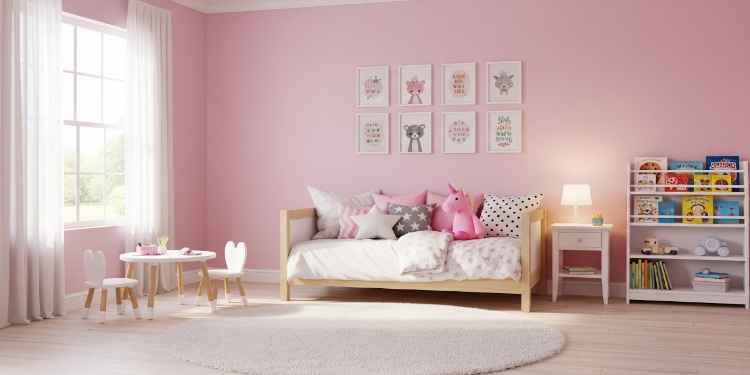The decoration of a child room is not just about bright colours and playful patterns. It is about creating a space that encourages creativity and is organised and pragmatic. All the features, such as storage and seating, must improve the way your child can learn, relax, and express himself or herself. The ideal spaces grow with their inhabitants and transform easily between toddler-dominated spaces to pre-teen paradise.
Colour That Inspires Growth
Colour shapes how children experience their surroundings. Soft tones promote calm while richer hues spark creativity. For example, introducing pink wall panels adds warmth and sophistication without overwhelming the eye. Colourful wall panels provide a modern backdrop that works beautifully with pastel accessories or bolder accents as tastes change over time. Flexible wall finishes allow families to refresh decor easily without costly renovations.
Furniture That Adapts Over Time
The purchase of multi-purpose furniture makes it unnecessary to replace items regularly. Flexible desks, portable storage boxes and adjustable beds adapt with the growth spurts and interest changes. The selection of durable materials will ensure the room survives several years of movement, games, and educational activities. Continuity is provided by a convertible cot or daybed which provides a comfortable spot to read or have a nap as your child grows up. Think about furniture that can be used for other purposes, a desk that becomes an art station or a bench that doubles up as a toy chest.
Smart Storage Without Sacrificing Style
Children build up possessions in a short time. Smart storage systems ensure that clutter is kept at bay and have a welcoming appearance. Floating shelves, wall-mounted baskets, and the drawers that are constructed beneath the bed make it easier to clean up. Clear containers will help children learn where objects should be and this will give them a sense of independence and routine. The inclusion of storage that fits the theme of the room also imparts a lesson on organisation without taking away the playfulness.
Play Zones That Encourage Creativity
Every child requires a place where they may explore and use their creativity. Quiet concentration is encouraged by a reading area with soothing lighting. Having art supplies in a craft area encourages creativity. Activity zones can be defined with carpets or different coloured wall panels to add structure without creating strict separations. Cushions, posters, and themed lighting are examples of décor pieces that may be rotated to reflect shifting interests and keep the space looking fresh.
Encouraging Free Movement
Adaptability is still a major consideration in the environment of a child. Open floor plans encourage unstructured games and teamwork. Flexible furniture allows children to modify their environment by themselves, which encourages independence and problem solving. A small table with puzzles can soon be transformed into a story-telling platform. Creativity and confidence are fostered in spaces that encourage participation.
Lighting That Supports Every Mood
Lighting influences comfort and focus. Layered lighting gives flexibility with the capability of combining stronger lighting levels during studying and soft glows during bedtime. Fairy lights and subtle LED strips are not distracting. In order to prevent glare, lamps should be positioned at varying heights. Where possible, natural light is better than artificial light, and it enhances a sense of being connected to nature.
Personal Touches That Tell a Story
Children are at home most in rooms that reflect their personality. The hanging of paintings, photographs or handcrafted artworks makes the space look like a mirror of their imagination. Drawing pictures or tying them on strings of twines glorifies creativity without messing up surfaces. Depth and character can be added by introducing patterns with textiles; curtains, cushions or throws. Get your child to be involved in the fabric or colour selection to create a sense of pride and ownership.
Design That Evolves Gracefully
A room that is thought over develops beautifully with the child that occupies it. By choosing classic foundations, one can update them easily with accessories. Replace cartoon prints with abstract art or neutral bedding as tastes evolve. Durable finishes and quality flooring will increase life span and any small changes are easy and affordable to make. Trendy items could become outdated very fast, so it is best to stick with universal design features that can be easily transferred across various developmental levels.
The Balance Between Fun and Function
A combination of versatile furniture, considered colour palette, and creative elements can help parents create an environment that can encourage curiosity and tranquility. A child’s room should be happy and functional, encouraging relaxation, laughing, and exploration in equal proportion. Any room can be turned into a place of learning, dreaming or simply having some quiet time with the loved ones.
David Prior
David Prior is the editor of Today News, responsible for the overall editorial strategy. He is an NCTJ-qualified journalist with over 20 years’ experience, and is also editor of the award-winning hyperlocal news title Altrincham Today. His LinkedIn profile is here.










































































